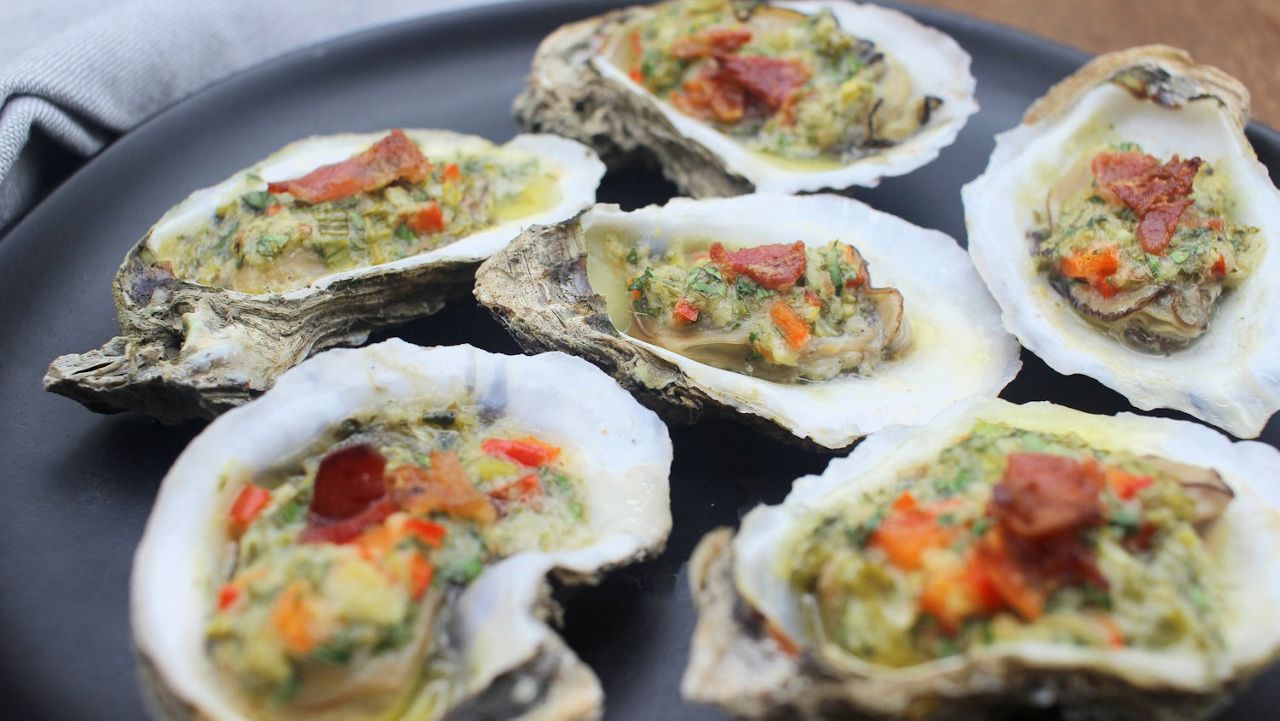November in North Carolina is peak oyster season, and there’s something about the briny chew of a fresh oyster that pairs well with the cool fall air.
Oysters have been part of coastal culture for as long as there have been people living on the marshes and sounds of North Carolina.
In the years after the Civil War, North Carolina lawmakers set the first official oyster season from September to April.
That season is more or less unchanged today, with wild oyster season open from Oct. 15 to March 31.
In North Carolina, people don’t need a license to harvest their own oysters. As long as you’re in an area open for oysters, anyone can take a bushel for personal use each day.
Over the past decade or so, North Carolina has seen a resurgence in oyster production, led by oyster farms that dot the inlets and sound-side waters. Farmed oysters can be harvested year-round.
North Carolina’s oyster farmers have been growing their operations, supplying local markets and restaurants and shipping the shellfish to other markets as far afield as New York City.
Oysters are available year-round in most fish markets and some grocery stores. Pay attention to where they come from – a good fish market will label the origin of its oysters, at least by state.
A good fishmonger will be able to tell you the specific sound or region the North Carolina oysters came from and if they’re farmed or wild caught. The taste of each oyster will vary depending on where along the coast it came from.
“For the best quality, shellfish should be consumed within 10 days of the harvest date. If properly refrigerated, they are still safe to eat for longer, but the quality will be diminished,” according to the North Carolina Division of Marine Fisheries.
After harvest, oysters should be kept at or below 45 degrees Fahrenheit until they’re cooked.
To prepare oysters, wash all the mud from them using water and a stiff brush. Any oysters that are open are no good and should be discarded. The same goes for oysters that don’t open when they’re cooked – they are also no good.
For the purists, there are really two ways to eat oysters. Take an oyster knife to a fresh oyster shell, pry it open, disconnect the meat from the shell, and eat it raw, perhaps with a little horseradish or hot sauce.
The second way is to roast them. Oyster roasts have a long tradition on the North Carolina coast. The idea is simple: put the oysters over an open fire for five to 10 minutes until they start to open, then eat them as they come off the fire.
You can also put wet burlap over the fire to steam the oysters – just make sure it stays wet and doesn’t catch on fire.
Oyster roasts traditionally will include hot sauce, horseradish, melted butter and crackers, so people can choose their own oyster adventure.
There are also fancier ways to serve oysters.
Since 1973, the Mariner’s Menu has been collecting and testing seafood recipes on the North Carolina coast. It started with the extension clubs in Carteret County and the entire collection is now online through SeaGrant at N.C. State University.
The collection includes more than two dozen oyster recipes. There are recipes for classics, like fried oysters and oyster stew, to adventurous concoctions like an open-faced oyster sandwich or a spicy seafood gumbo with oysters.
Here’s a small selection of recipes from Mariner’s Menu:
- 24 oysters on the half shell
- 6 tablespoons unsalted butter
- 6 tablespoons frozen chopped spinach, thawed
- 3 teaspoons onion, minced
- 1 tablespoons dried parsley flakes
- 3 tablespoons celery, minced
- ⅛ teaspoon fennel seed, ground
- ⅛ teaspoon dried tarragon leaves
- ⅛ teaspoon dried parsley
- ⅛ teaspoon cayenne pepper
- ⅛ teaspoon garlic powder
- ¼ cup breadcrumbs
- rock salt
“Place the rack in the top third of the oven and preheat the broiler on low.
“Combine butter, spinach and seasonings. Simmer for 15 minutes. Puree in blender. Add breadcrumbs. Spread a layer of rock salt on a baking sheet. Arrange oysters on rock salt and spread 1 teaspoon of spinach mixture over each oyster.
“Broil for about 4 minutes or until oysters are done. Watch oysters closely while broiling.”
Cornbread-oyster dressing (or stuffing)
- 2 cups oysters, drained, liquid reserved
- 3 tablespoons butter
- ¾ cup onion, chopped
- ¾ cup celery, chopped
- ½ teaspoon salt
- ¼ teaspoon black pepper, freshly ground
- 2 cups cornbread, crumbled
- 2 cups soft bread crumbs
- 1 tablespoon dried parsley
- ¾ teaspoon dried sage
- 2 eggs, beaten
“Preheat the oven to 400° F. Cook Cornbread and set aside.
“Lower the oven temperature to 350° F.
“Melt butter in a medium saucepan. Lightly sauté onion and celery. Add salt and pepper.
“In a large bowl, combine cornbread and crumbs. Add sautéed vegetables, parsley, sage and eggs. Add oysters and toss lightly. Gently mix in enough reserved oyster liquid until dressing is moist, but not packed.
“Place in a shallow greased baking pan and bake, uncovered, at 350° F until done through and crusty outside, about 30 to 40 minutes.”
“This recipe was contributed by the late Eloise Pigott of Gloucester, N.C., in the June/July 1983 issue of Coastwatch.
“When preparing this recipe, I used 1/4 cup of flour and 1/8 teaspoons of salt and pepper. Don’t let this simple recipe fool you, it’s amazing.
- Chopped oysters (about 1 cup)
- 1 egg, beaten
- Flour
- Salt and pepper
“Mix together chopped oysters, beaten egg and seasonings. Add just enough flour to hold together. Drop by spoonful into hot grease. Fry until golden.”









